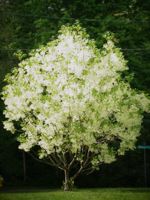Mon-Fri 9am - 5pm Mountain time
Western Snowberry vs White Fringe Tree
Symphoricarpos occidentalis
Chionanthus virginicus
NOT AVAILABLE THIS SEASON - MIGHT RETURN
NOT AVAILABLE THIS SEASON - MIGHT RETURN
Like the Common Snowberry, the Western Snowberry is a small shrub with pink flowers useful for feeding livestock and preventing erosion. Unlike the common species, however, the Western Snowberry is much more suited to wet conditions, capable of persevering through poor soil drainage and occasional flooding.
After the Snowberry's flowers have bloomed, it produces berries which often last on the plant through winter. These berries are toxic to humans, but livestock and local wildlife love them! Those hoping to attract wildlife to their property can plant Snowberry and expect to see animals foraging on it much later in the year than other plants.
White Fringe Tree is known for its fringe-like white flowers. It can either grow as a small tree or a large multistemmed shrub. The White Fringe Tree has separate male and female plants. Both male and female flowers have white fringe-like petals, but the male flowers are longer and showier. The female flowers give way to clusters of dark blue to black berries. These berries are not edible for humans but attract birds and other wildlife.
The White Fringe Tree is tolerant of clay soils, saline soils, and air pollution but does not do well in prolonged dry conditions.
Western Snowberry Quick Facts
White Fringe Tree Quick Facts
Toxicity: berries are toxic to humans

